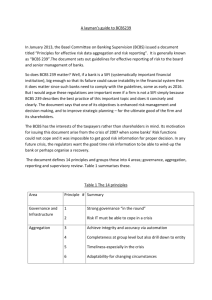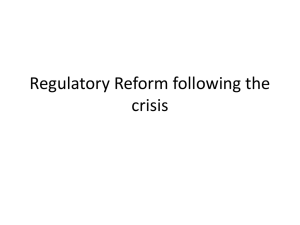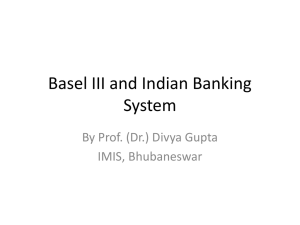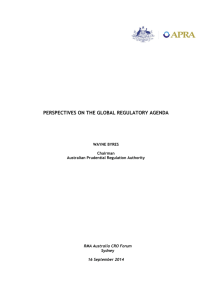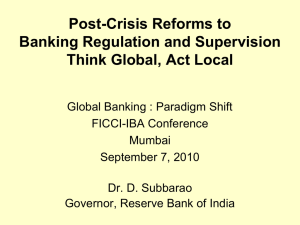DIIS polIcy brIef Reforming Global Banking Rules − how the G20
advertisement
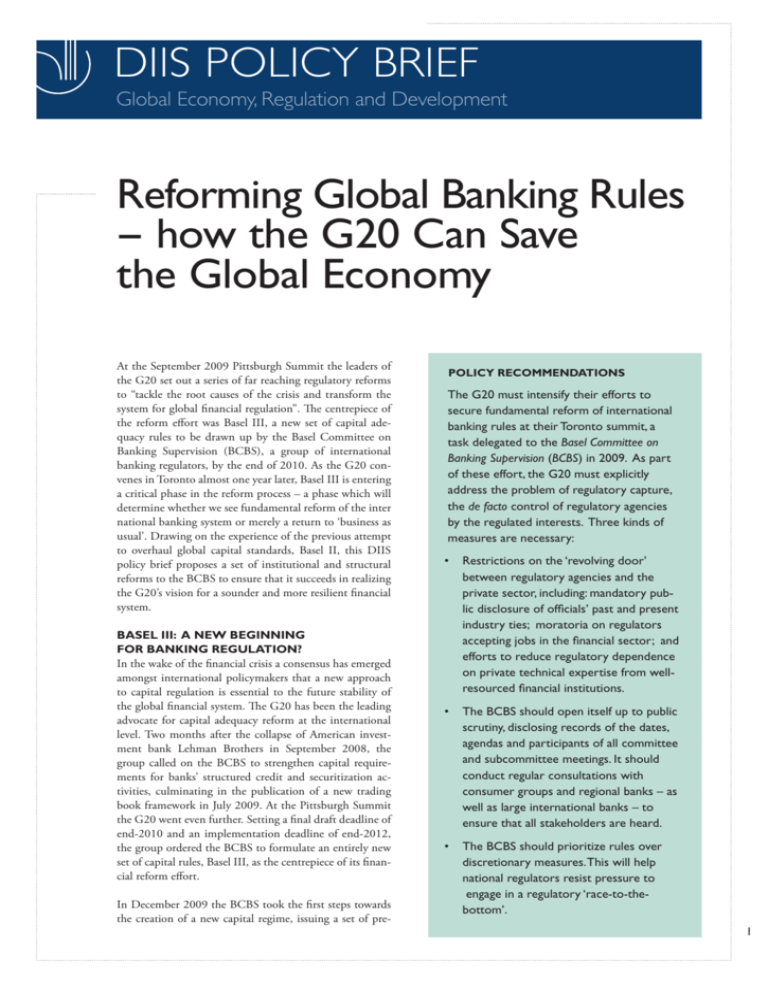
DIIS policy brief Global Economy, Regulation and Development Reforming Global Banking Rules − how the G20 Can Save the Global Economy At the September 2009 Pittsburgh Summit the leaders of the G20 set out a series of far reaching regulatory reforms to “tackle the root causes of the crisis and transform the system for global financial regulation”. The centrepiece of the reform effort was Basel III, a new set of capital adequacy rules to be drawn up by the Basel Committee on Banking Supervision (BCBS), a group of international banking regulators, by the end of 2010. As the G20 convenes in Toronto almost one year later, Basel III is entering a critical phase in the reform process – a phase which will determine whether we see fundamental reform of the inter national banking system or merely a return to ‘business as usual’. Drawing on the experience of the previous attempt to overhaul global capital standards, Basel II, this DIIS policy brief proposes a set of institutional and structural reforms to the BCBS to ensure that it succeeds in realizing the G20’s vision for a sounder and more resilient financial system. Basel III: A New Beginning for Banking Regulation? In the wake of the financial crisis a consensus has emerged amongst international policymakers that a new approach to capital regulation is essential to the future stability of the global financial system. The G20 has been the leading advocate for capital adequacy reform at the international level. Two months after the collapse of American investment bank Lehman Brothers in September 2008, the group called on the BCBS to strengthen capital requirements for banks’ structured credit and securitization activities, culminating in the publication of a new trading book framework in July 2009. At the Pittsburgh Summit the G20 went even further. Setting a final draft deadline of end-2010 and an implementation deadline of end-2012, the group ordered the BCBS to formulate an entirely new set of capital rules, Basel III, as the centrepiece of its financial reform effort. In December 2009 the BCBS took the first steps towards the creation of a new capital regime, issuing a set of pre- policy recommendations The G20 must intensify their efforts to secure fundamental reform of international banking rules at their Toronto summit, a task delegated to the Basel Committee on Banking Supervision (BCBS) in 2009. As part of these effort, the G20 must explicitly address the problem of regulatory capture, the de facto control of regulatory agencies by the regulated interests. Three kinds of measures are necessary: • Restrictions on the ‘revolving door’ between regulatory agencies and the private sector, including: mandatory public disclosure of officials’ past and present industry ties; moratoria on regulators accepting jobs in the financial sector; and efforts to reduce regulatory dependence on private technical expertise from wellresourced financial institutions. • The BCBS should open itself up to public scrutiny, disclosing records of the dates, agendas and participants of all committee and subcommittee meetings. It should conduct regular consultations with consumer groups and regional banks – as well as large international banks – to ensure that all stakeholders are heard. • The BCBS should prioritize rules over discretionary measures. This will help national regulators resist pressure to engage in a regulatory ‘race-to-thebottom’. DIIS policy brief liminary proposals whose details would be filled in over subsequent rounds of negotiations during 2010. There are four key elements to the latest proposals: (i) International leverage ratio: a simple ratio of equity to total assets introduced as a safeguard against the risks inherent in the use of internal models. (ii) Countercyclical capital buffers: buffers which rise above regulatory minima in economic booms and can be subsequently drawn upon as losses are incurred during downturns. (iii) More restrictive definitions of capital, aimed at improving the loss absorption capacity of banks’ capital bases. (iv) Minimum liquidity standard: a standard determining the minimum ratio of highly liquid assets to total assets that banks are required to hold to cover temporary funding shortfalls. The BCBS’s proposals have caused alarm in the finance industry and in the eyes of some commentators have heralded a new era in the history of banking regulation – an era of ‘more capital, more liquidity and less risk’. Such conclusions are premature. With the drafting process entering its final stages the BCBS has come under increasing pressure from the banking industry to water down its latest proposals. In April 2010, the deadline for comments on the proposals, the BCBS was flooded with protests from large financial institutions warning that Basel III could destroy the economic recovery, potentially triggering a ‘double-dip’ recession. One prominent French bank claimed that the proposals would produce “two years of recession guaranteed, or four years of zero growth” in Europe. More recently the Institute of International Finance (IIF), the major lobby group for large international banks, released a study estimating that the proposals would cause a cumulative reduction in GDP of $920 billion (4.3% of GDP) in the euro zone and $951 billion (2.7% of GDP) in the United States by 2015 – representing an overall loss of more than nine million jobs across the global economy. These assessments have not been confirmed by independent analysis. The chief economic advisor to the Bank of International Settlements, for instance, suggested in May that “the net impact of the Basel committee reforms on growth will be negligible” and “our preliminary assessment is that improvements to the resilience of the financial system will not permanently affect growth – except for possibly making it higher”. Nevertheless, it is not yet clear whether the BCBS will be able to resist the industry’s lobbying campaign and ensure that crucial provisions of Basel III emerge intact from the regulatory process. Are we going to see a new beginning for banking regulation? Or are we going to see, thanks to the pervasive influence of regulatory capture, a return to ‘business as usual’? Lessons from the Past: The Failure of Basel II We are in familiar territory. Eleven years ago, partly in response to the Asian financial crisis, the BCBS set out to introduce more stringent international capital standards. The existing regime, the 1988 Accord on Capital Adequacy (Basel I), had failed to keep up with the pace of financial innovation, providing banks with easy opportunities to engage in regulatory arbitrage – reducing capital without reducing risk – through activities such as securitization. By closing loopholes in the 1988 Accord the Committee hoped to maintain the current levels of capital in the banking system while creating a more “comprehensive approach to addressing risk”. As the reform process finally drew to a close in 2004, however, it became clear that the BCBS had failed to achieve these objectives (see table). Basel II, as the agreement came to be known, gave the largest banks the option to use internal risk models in their capital calculations, allowing these banks to effectively set their own capital requirements. Instead of increasing risk sensitivity, the use of internal estimates provided banks with an incentive to minimize capital and engage in even riskier practices. The result was an dramatic decline in overall capital levels in the banking system – in explicit contradiction to the BCBS’s original aim. The BCBS also failed to achieve its aim of creating a more comprehensive approach to risk assessment. As well as allowing negligible levels of capital to be held against securitization exposures, Basel II largely ignored the risks associated with the trading book – the portfolio of assets traded in capital markets rather than held until maturity. Needless to say, it was these assets that expirienced the heaviest losses in the financial crisis. What went wrong? The answer lies in the institutional context within which Basel II was drafted. The BCBS operated as an exclusive ‘club’, disclosing no information about its activities and restricting membership to G10 countries. Even more worryingly the BCBS consulted only a handful of large international banks, with which it had close personal links. The longest-serving chairman of the BCBS was in fact a cofounder of the IIF, the most influential lobby group in negotiations for Basel II. The man who presided over most of the BCBS’s work on Basel II, meanwhile, was a close friend of the IIF’s managing director through his twenty-two year stint at a major American bank. These conditions allowed large international banks to exert a disproportionate influence over the content of Basel II, skewing regulatory outcomes in their favour at the expense of their smaller rivals and, ultimately, the stability of the global financial system. Conclusion Ominously for Basel III many of the conditions that undermined the previous attempt to regulate banking systems are still in place today. Indeed, there are already signs that history may be repeating itself. At a meeting in South Korea earlier this month G20 finance ministers indicated that, on the advice of the BCBS, they would delay implementation of Basel III from the original 2012 deadline to between 2014 and 2016. Meanwhile, members of the BCBS have privately admitted that many of the key elements of Basel III – such as the leverage ratio and countercyclical capital buffers – may be shifted to ‘Pillar 2’ of the accord, rendering them non-binding and leaving their implementation to the discretion of national supervisors. It is therefore essential that the G20, as it meets in Toronto this week, heeds the lessons of Basel II’s failure. By adopting the kinds of institutional reform proposed in this brief can we put ourselves in a position to create rules that serve the interests of society as a whole, and not just those being regulated. Ranjit Lall ranji.lall@merton.oxon.org Martin Højland mhl@diis.dk Jakob Vestergaard jve@diis.dk INITIAL PROPOSALS AND FINAL OUTCOMES IN BASEL II AreaInitial proposalIndustry Final accord Recommendation (Basel II) Credit RiskIncorporate credit Recognize internalRecognition of ratings from external credit risk models internal credit risk credit rating agencies of large banks models for large into the framework banks Market RiskStandardized Substitute standard-Recognition of VaR methodology based ized methodology for models in 1996 on fixed risk internal market risk parameters (VaR) models Trading BookIntroduce capital charge for derivatives risk; capture counter- party credit risk in the trading book Securitization Link risk weights to external credit ratings Drop capital charge Capital charge for for derivatives risk; derivatives risk do not apply counter- abolished in 2001; party credit risk minimal regulation capital requirements of trading book to trading book Lower risk weights forReduced risk weights rated tranches for rated tranches Source: Lall, 2010 DIIS policy brief SUGGESTED READINGS Lall, Ranjit (2010). Reforming Global Banking Rules: Back to the Future? DIIS Working Paper 2010:16 Højland, Martin & Vestergaard, Jakob (2010). Governing through Standards: The Elusive Case of Banking. Paper presented at the ‘Governing through Standards’ conference at the Danish Institute for International Studies, 24–26 February 2010. Tsingou, Eleni (2009). Revolving Doors and Linked Ecologies in the World Economy: Policy Locations and the Practice of International Financial Reform. CSGR Working Paper 260/09. Centre for the Study of Globalisation and Regionalisation, Department of Politics and International Studies, University of Warwick. Baker, Andrew (2010). Restraining Regulatory Capture? Anglo-America, Crisis Politics and Trajectories of Change in Global Financial Governance. International Affairs, Volume 86, Issue 3, Blackwell Publishing and Chatham House. The Warwick Commission (2009). The Warwick Commission on International Financial Reform: In Praise of Unlevel Playing Fields. University of Warwick, Coventry, UK. Giles, Chris (2010). Bankers’ ‘doomsday scenarios’ under fire from Basel study chief. Financial Times, May 31st 2010, website: http://www.ft.com/cms/s/0/df82600a-6c4a-11df-86c5-00144feab49a.html DIIS · DANISh institute for International Studies Strandgade 56, 1401 Copenhagen, Denmark · Tel +45 32 69 87 87 · Fax + 45 32 69 87 00 · e-mail: diis@diis.dk · www.diis.dk


